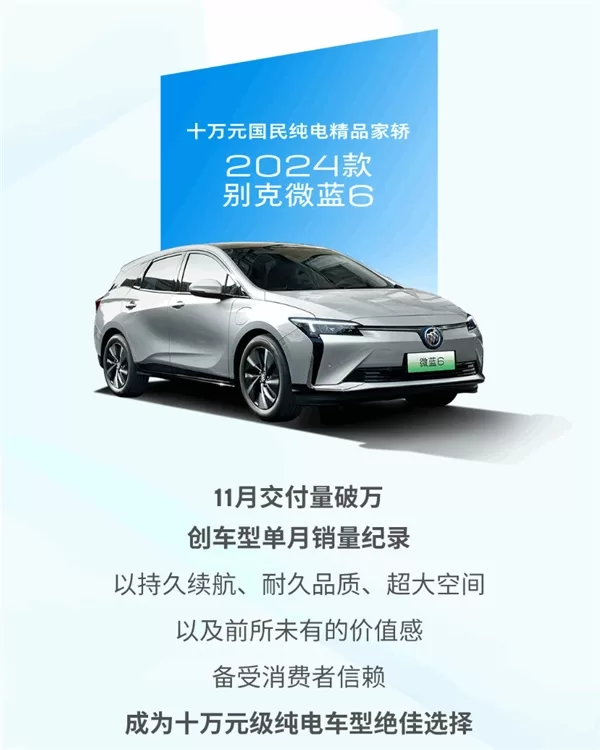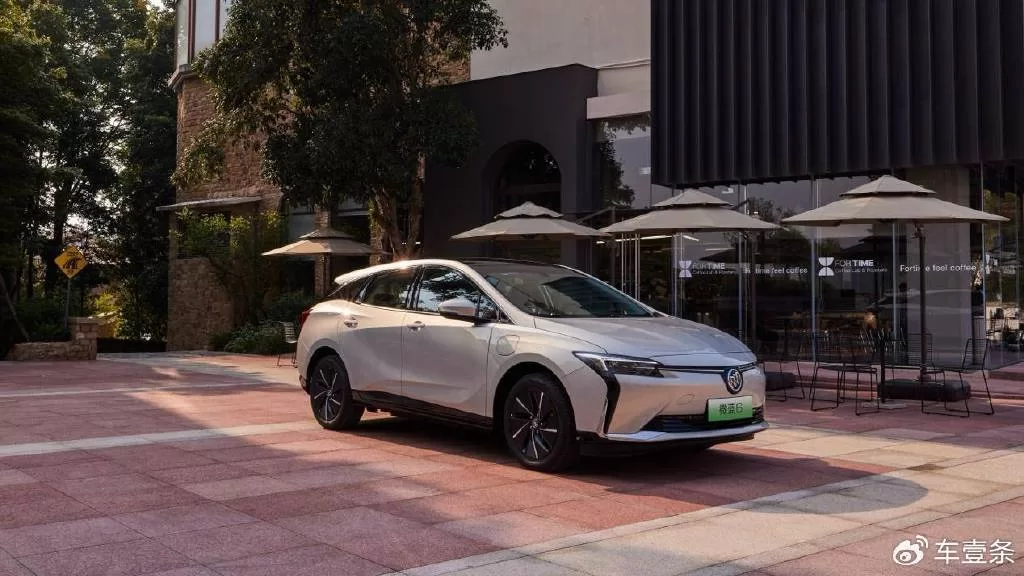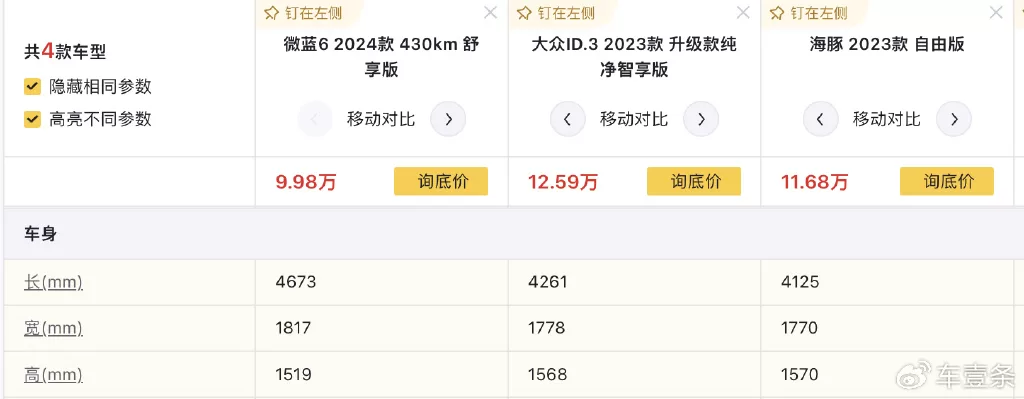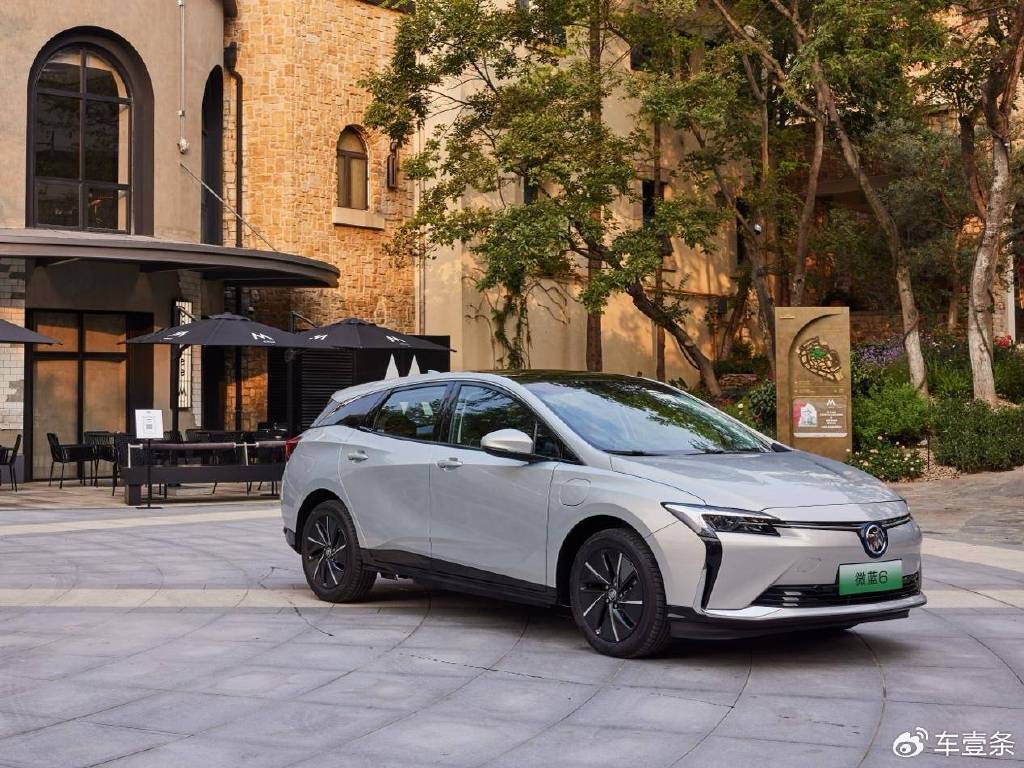When everyone focuses on prices, factors beyond prices become more prominent. In early December, it’s time for car manufacturers to announce their November sales figures. In the current highly competitive Chinese car market, every brand and product that emerges from the segmented market comes with a sense of “aggression”, and the sales rankings in the segmented market have never been as “unstable” as they are now. In the just-passed November, the market for pure electric cars priced at around 100,000 yuan (14050$), which is considered one of the most competitive segments in the industry, also saw some new changes. Among the familiar faces, the Buick Velite 6 stood out, setting a new monthly sales record in November with a delivery volume of over 10,000 units.
If we take the October sales as a reference, the Buick Velite 6 has achieved sales of over 10,000 units in June, which can basically be ranked in the top 5 of pure electric vehicle sales in the 100,000 level. This achievement is commendable for both Buick itself and the overall joint venture brand. The reason for the breakthrough of the Buick Velite 6 is first thought to be related to its official starting price of 99,800 yuan (14020$). The actual starting price is certainly the key to its success, but not the only reason. Looking at the product development process, the Buick Velite 6 is not a very new model. After its launch, sales have remained stable at 2,000-3,000 units per month. On the one hand, this is because the new energy vehicle market was still in its infancy at that time; on the other hand, it is because it still follows the pricing system inherited from the joint venture brand’s era of fuel vehicles. This makes the Velite 6 not easily noticed by consumers at first, and with a large number of new models emerging subsequently, consumers are overwhelmed. However, with Buick’s comprehensive transformation offensive in 2023, the Velite 6 also received a “rebirth”. In October, the 2024 Buick Velite 6 was newly launched, with an official starting price of 99,800 yuan (14020$). Riding on Buick’s “same price for oil and electricity” strategy, the Velite 6’s renewal this time is quite sincere – a standard A-class sedan, but sold at the price of an A0-class car. This move quickly increased attention and terminal sales for the Velite 6.
In October, Weilan 6 was just starting to gain momentum in the market, and in November it successfully achieved over 10,000 deliveries, demonstrating the decisive strength and effectiveness of Buick’s approach. A similar case can already be seen in the joint venture brand, SAIC Volkswagen’s ID.3, which also saw significant success after a major price adjustment during the market competition. Judging from the sales momentum of the ID.3, it’s highly likely that the hot sales of Weilan 6 are just beginning.
Currently, the breakthrough of Buick Weilang 6 relies on first “rolling prices” to forcefully enter the consumer’s field of vision, and then relying on its own comprehensive product strength to retain consumers. This strategy seems simple on the surface, but it is not easy to truly implement. In order to “roll prices”, Buick not only needs courage and execution, but also needs a “foundation”, and Buick has both. The determination of transformation is unquestionable, and Buick has clearly demonstrated it in a series of transformation actions this year. As for the foundation of rolling prices, Buick is also outstanding, whether it is the continuous contribution of profits from fuel vehicles, or the scale effect of SAIC-GM’s layout in the upstream and downstream of the new energy supply chain, it all gives the brand the strength to become the “price roller”. Therefore, facing the market opportunity, Buick decisively rolls out. By rolling out the experience, Weilang 6 retains consumers with its strength. As mentioned earlier, the breakthrough strategy of Weilang 6 is to first roll prices, make itself visible, and then roll out the comprehensive product experience, making itself chosen. Therefore, in addition to price, the comprehensive product experience is also very important. How strong is Weilang 6? We can compare it with the popular BYD Dolphin and SAIC Volkswagen ID.3 in the 100,000 yuan (14050$) pure electric market to understand the product points of Weilang 6. First, size and space. In terms of size, the Dolphin and ID.3 are A0-level models, while Weilang 6 is clearly a standard A-level car, so its advantages in size and space are quite obvious.
Specifically, the Weilan 6 has more than 20 storage spaces in the car. After folding the rear seats in a 6/4 split, the trunk volume can be expanded to a maximum of 1098L, meeting the needs of family travel, which is better than the Dolphin and ID.3. Although consumers of this level of car may not have very strict requirements for large spaces, if they can buy a car with a larger space at a similar price, no consumer would be unwilling. Therefore, the advantages of Weilan 6 in size and space will leave a more profound impression on consumers comparing these three cars. Next, solid battery performance. The Weilan 6, Dolphin, and ID.3 have a range of 430km, 420km, and 450km respectively. All three cars are also equipped with fast charging. The Weilan 6 and Dolphin both take 30 minutes to charge from 30% to 80% at room temperature, while the ID.3 takes about 40 minutes to charge from 0-80%, with little difference in charging efficiency.
In terms of power, the Weilan 6 is more powerful, thanks to the eMotion intelligent electric drive technology. The new car is equipped with a permanent magnet synchronous motor with a maximum power of 130kW and a maximum torque of 265N·m; the ID.3 has a maximum power of 125kW and a maximum torque of 310N·m, slightly better than the Weilan 6; the Dolphin has a maximum power and maximum torque of only 70kW and 180N·m respectively. Based on such endurance and power performance, the Weilan 6 performs outstandingly in endurance solidity, and its endurance authenticity has been highly praised since its launch. Many consumers even buy it for its endurance authenticity, as can be seen from its comprehensive electricity consumption of only 12.7kWh per hundred kilometers. Furthermore, reliable safety. Safety is one of the most concerned product points for current electric vehicle consumers, and all three models perform well in this aspect. Specifically, the new car is based on the development of a new energy five-star car body structure, adopting a high-performance BFI integrated body structure, and has independently created a high-strength dual-frame protection structure for collision safety from the beginning of the design, as well as adding a design of multiple through-type anti-collision beams on the body to provide all-round collision protection for the battery pack.
In terms of electrical safety, the new car’s battery management system and key driving subsystems are developed to the highest functional safety level of ASIL-D. The power battery has undergone seven-fold 13-category extreme safety tests such as puncture, compression, immersion, fire, overcharge, overdischarge, and short circuit, as well as additional drop and lateral pillar impact tests; the new car also strictly follows the standard test of the General Global New Energy Vehicle Certification System. As a model produced by a joint venture with a proven track record of safety and reliability over the years, there is no need to doubt the reliability of the Weilan 6. Finally, brand recognition. As the joint venture brand camp accelerates in the overall electrification transformation, consumers’ high value recognition of joint venture brands is returning, spending the same amount of money to buy a joint venture brand is still very attractive to many consumers, not to mention that a joint venture brand also means a richer channel layout and a more complete service system.
This is another important reason why Weilai 6 attracts consumers’ attention and is ultimately chosen. In the end, the price is the best to roll, and also the most difficult to roll, because when everyone starts to roll the price, other factors beyond the price will become more crucial in influencing consumers’ choices. Therefore, ultimately, in the current Chinese car market, the comprehensive strength of the product is still the most important. In this respect, Buick is clearly not afraid of “internal competition”, and Weilai 6 is a clear proof.







